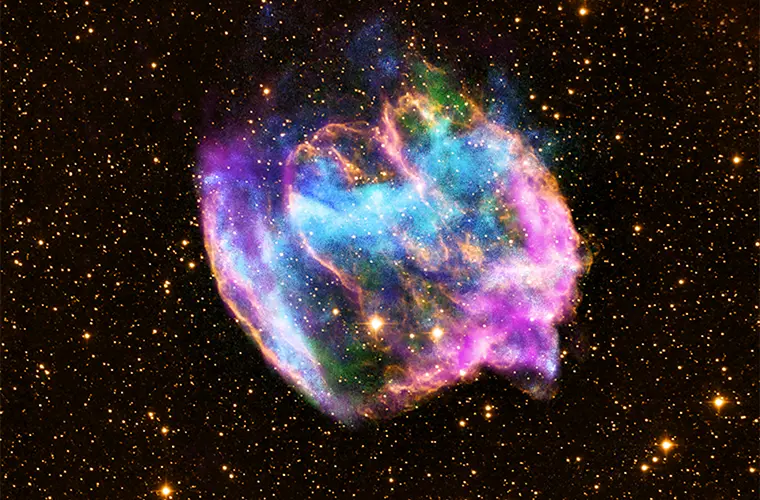A new study from the University of California, Berkeley suggests that the next nearby supernova could not only illuminate our skies but also provide a window into the elusive nature of dark matter, thanks to a hypothesized particle known as the axion.
“If we were to see a supernova, like supernova 1987A, with a modern gamma-ray telescope, we would be able to detect or rule out this QCD axion, this most interesting axion, across much of its parameter space — essentially the entire parameter space that cannot be probed in the laboratory, and much of the parameter space that can be probed in the laboratory, too,” Dr. Benjamin Safdi, a UC Berkeley associate professor of physics and lead study author, said in a release. “And it would all happen within 10 seconds.”
Researchers proposed their findings in a paper recently published in the journal Physical Review Letters.
Supernovae: A Cosmic Fireworks Display
In the quiet expanse of the cosmos, supernovas are cosmic fireworks marking the end of a star’s life. But they could also be vital to understanding one of the universe’s most elusive phenomena: dark matter.
Researchers at the Berkeley Center for Theoretical Physics have proposed a revolutionary way to use stellar explosions as laboratories for detecting axions—hypothetical particles that may solve fundamental mysteries about the cosmos.
First theorized in the 1970s to address the “strong-CP problem” in particle physics, axions have since emerged as a leading candidate for dark matter, the invisible substance thought to comprise about 85% of the universe’s mass. Unlike ordinary matter, dark matter does not emit, absorb, or reflect light, making it notoriously difficult to study.
If they exist, axions could bridge this gap. They are believed to interact only weakly with other particles, allowing them to escape dense environments like the cores of stars. However, their subtle interactions with magnetic fields could reveal their presence in the form of detectable gamma rays.
A Look at Supernova 1987A
In this recent study, Berkeley researchers revisited Supernova 1987A, the closest observed supernova in modern history. Located in the Large Magellanic Cloud, this stellar explosion provided invaluable data on neutrinos—ghostly particles that offered insight into the event’s inner workings. However, no gamma-ray signals associated with axions were detected at the time.
Using advanced simulations and updated astrophysical models, the researchers demonstrated that axions might produce gamma rays detectable by current or future instruments.
The magnetic fields of progenitor stars—those that eventually explode as supernovas—play a crucial role. If axions are produced within the collapsing core of a dying star, they could interact with these magnetic fields to create gamma-ray signals before the explosion’s shockwave alters the star’s structure.
“This has really led us to thinking about neutron stars as optimal targets for searching for axions as axion laboratories,” Dr. Safdi said. “Neutron stars have a lot of things going for them. They are extremely hot objects. They also host very strong magnetic fields.”
“The strongest magnetic fields in our universe are found around neutron stars, such as magnetars, which have magnetic fields tens of billions of times stronger than anything we can build in the laboratory. That helps convert these axions into observable signals.”
With about one supernova occurring every century in our galaxy, the next event could happen anytime. The Berkeley researchers emphasize the need for a robust observational infrastructure to seize this rare opportunity.
Their proposed solution? A network of gamma-ray telescopes providing continuous full-sky coverage dubbed the GALAXIS project. This ambitious project would enable real-time detection of axion-induced gamma-ray bursts, offering unprecedented sensitivity to axion signals.
Gamma Ray Telescopes
“I think all of us on this paper are stressed about there being a next supernova before we have the right instrumentation,” Dr. Safdi said. “It would be a real shame if a supernova went off tomorrow and we missed an opportunity to detect the axion — it might not come back for another 50 years.”
“Without new instrumentation, the opportunity to probe QCD axions using gamma-ray observations of the next Galactic SN will almost certainly be lost since the event will likely have no advanced warning,” researchers wrote. “We thus propose a full-sky gamma-ray telescope network, which we call the GALactic AXion Instrument for Supernova.”
The study’s implications go far beyond particle physics. By confirming the existence of axions, scientists could unlock a new understanding of dark matter and its role in the universe. Moreover, axions could also offer insights into the fundamental forces shaping the cosmos, including those described by quantum chromodynamics (QCD).
The GALAXIS project could complement other experimental efforts to detect axions, such as the International Axion Observatory (IAXO) and the Axion Dark Matter Experiment (ADMX). Together, these initiatives could refine the parameters for axion mass and coupling strength, narrowing the search for these elusive particles.
“It seems almost impossible to have a consistent theory of gravity combined with quantum mechanics that does not have particles like the axion,” Dr. Safdi explained.
Detecting axions remains a formidable challenge. The faint signals predicted by theoretical models require cutting-edge instruments with unparalleled sensitivity. Furthermore, astrophysical uncertainties, such as the strength and configuration of magnetic fields in progenitor stars, add layers of complexity to the analysis.
Nevertheless, the Berkeley team is optimistic. Their projections suggest that even with current gamma-ray observatories like the Fermi Large Area Telescope, the next galactic supernova could provide critical data to detect axions or constrain their properties further.
“The best-case scenario for axions is Fermi catches a supernova. It’s just that the chance of that is small,” Dr. Safdi said. “But if Fermi saw it, we’d be able to measure its mass. We’d be able to measure its interaction strength. We’d be able to determine everything we need to know about the axion, and we’d be incredibly confident in the signal because there’s no ordinary matter which could create such an event.”
The Next Golden Age of Discovery?
The fusion of astrophysics and particle physics is driving a golden age of discovery, and by leveraging the violent deaths of stars, researchers are pushing the boundaries of our understanding of the universe.
If axions are detected, it would mark a seismic shift in physics, offering answers to questions that have puzzled scientists for decades.
Ultimately, as we await the next cosmic explosion, one thing is clear: the universe is not just a stage for celestial events—it’s a laboratory teeming with opportunities to explore the unknown.
Whether or not axions are part of the dark matter puzzle, the search itself promises to unveil new layers of reality, illuminating not just the cosmos but our place within it.
Tim McMillan is a retired law enforcement executive, investigative reporter and co-founder of The Debrief. His writing typically focuses on defense, national security, the Intelligence Community and topics related to psychology. You can follow Tim on Twitter: @LtTimMcMillan. Tim can be reached by email: tim@thedebrief.org or through encrypted email: LtTimMcMillan@protonmail.com

